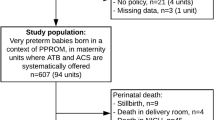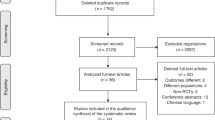Abstract
OBJECTIVE: To compare the clinical and cost-effectiveness of treating recurrent preterm labor with continuous subcutaneous terbutaline versus oral tocolytics in twin gestations.
STUDY DESIGN: In a retrospective, matched-cohort design, twin pregnancies treated as outpatients with continuous subcutaneous terbutaline were identified from a perinatal database, then matched 1:1 by gestational age at recurrent preterm labor to those receiving oral tocolytics. There were 353 patients per treatment group. A cost model was used to compare antepartum hospital, nursery, and outpatient charges.
RESULTS: Infants of the subcutaneous terbutaline group had greater gestational age at delivery, higher birth weights, and less frequent neonatal intensive care unit admission. Charges for antepartum hospitalization and nursery were significantly less in the subcutaneous terbutaline group, while charges for outpatient services were less for the oral group. Mean total estimated charges were US$17,109 less for those receiving subcutaneous terbutaline.
CONCLUSION: Improved clinical outcomes and decreased nursery utilization suggest cost-effectiveness of outpatient continuous subcutaneous terbutaline versus oral tocolytics for the treatment of recurrent preterm labor.
This is a preview of subscription content, access via your institution
Access options
Subscribe to this journal
Receive 12 print issues and online access
$259.00 per year
only $21.58 per issue
Buy this article
- Purchase on Springer Link
- Instant access to full article PDF
Prices may be subject to local taxes which are calculated during checkout
Similar content being viewed by others
References
Ventura SJ, Martin JA, Curtin SC, Mathews TJ Births: Final Data for 1997. National Vital Statistics Reports vol. 47 no. 18 Hyattsville, MD: National Center for Health Statistics 1999
Callahan TL, Hall JE, Ettner SL, Christiansen CL, Greene MF, Crowley WF The economic impact of multiple-gestation pregnancies and the contribution of assisted reproduction techniques to their incidence N Engl J Med 1994 331 244–249
Levene MI, Wild J, Steer P Higher multiple births and the modern management of infertility in Britian Br J Obstet Gynecol 1992 146 862–868
Ettner SL, Christiansen CL, Callahan TL, Hall JE How low birth weight and gestational age contribute to increased inpatient costs for multiple births Inquiry 1997/1998 34 325–339
Goldenberg RL, Iams JD, Miodovnik M, et al The preterm prediction study: risk factors in twin gestations Am J Obstet Gynecol 1996 175 1047–1053
Luke B The changing pattern of multiple births in the United States: maternal and infant characteristics, 1973–1990 Obstet Gynecol 1994 84 101–106
Luke B, Keith LG The contribution of singletons, twins and triplets to low birth weight, infant mortality and handicap in the United States J Reprod Med 1992 37 661–666
Derom R, Derom C, Vlietinck R, Van Maele G, Van Den Berghe H Twin pregnancies after medically assisted reproduction: epidemiology, comparative perinatal morbidity and mortality J Perinat Med 1991 19 (Suppl 1) 229–233
HCUPnet, Healthcare Cost and Utilization Project, Agency for Healthcare Research and Quality Rockville, MD. Comorbidities/Insurance/Discharges — Hospitalization in the United States 1997 http://www.ahrq.gov/gov/data/hcup/hcupnet
American College of Obstetricians and Gynecologists Special problems of multiple gestation ACOG Educational Bulletin 253 Washington, DC: ACOG 1998
Malone FD, Chelmow D, Athanassiou A, D'Alton ME Impact of gestational age at delivery on the economics of triplet pregnancy J Matern–Fetal Med 1999 8 256–261
Haas JS, Berman S, Goldberg AB, Lee LWK, Cook EF Prenatal hospitalization and compliance with guidelines for prenatal care Am J Public Health 1996 86 815–819
Scott CL, Chavez GF, Atrash HK, Taylor DJ, Shah RS, Rowley D Hospitalizations for severe complications of pregnancy, 1987–1992 Obstet Gynecol 1997 90 225–229
Agency for Healthcare Research and Quality HCUP-3 Nationwide Inpatient Sample (NIS) Release 3. Data, Documentation and Tools 1994 http://www.ahcpr.gov
Rogowski J Measuring the cost of neonatal and perinatal care Pediatrics 1999 103 329–335
Berg G, Anderson RGG, Ryden G Beta-adrenergic receptors in human myometrium during pregnancy: changes in the number of receptors after beta-mimetic treatment Am J Obstet Gynecol 1985 85 313–317
Perry KG, Morrison JC, Rust OA, Sullivan CA, Martin RW, Naef RW Incidence of adverse cardiopulmonary effects with low-dose continuous terbutaline infusion Am J Obstet Gynecol 1995 173 1273–1277
Allbert JR, Johnson C, Roberts WE, Martin RW, Gookin KS, Morrison JC Tocolysis for recurrent preterm labor using a continuous subcutaneous infusion pump J Reprod Med 1994 38 614–618
King JF, Grant A, Keirse MJNC, Chalmers I Beta-mimetics in preterm labour: an overview of the randomized controlled trials Br J Obstet Gynaecol 1988 95 211–222
Lewis R, Mercer BM, Salama M, Walsh MA, Sibai BM Oral terbutaline after parenteral tocolysis: a randomized, double-blind, placebo-controlled trial Am J Obstet Gynecol 1996 175 834–837
Rust OA, Bofill JA, Arriola RM, Andrew ME, Morrison JC The clinical efficacy of oral tocolytic therapy Am J Obstet Gynecol 1996 175 838–842
Sanchez-Ramos L, Kaunitz AM, Gaudier FL, Delke I Efficacy of maintenance therapy after acute tocolysis: a meta-analysis Am J Obstet Gynecol 1999 181 484–490
Lam F, Gill PJ, Smith M, Kitzmiller JL, Katz M Use of subcutaneous terbutaline pump for long-term tocolysis Obstet Gynecol 1988 72 810–813
Lam F, Gill PJ, Smith M, Kitzmiller JL, Katz M Comparison of portable subcutaneous terbutaline pump and oral terbutaline treatment for long-term tocolysis: a randomized clinical trial Eighth Annual Meeting, Society of Perinatal Obstetricians. Las Vegas, NV, February 1988, Abstract 400
Lam F, Bergauer NK, Coleman SK, Stanziano GJ, Jacques D A comparison of gestational days gained with oral terbutaline versus continuous subcutaneous terbutaline in women with twin gestations J Perinatol 2000 20 408–413
Author information
Authors and Affiliations
Rights and permissions
About this article
Cite this article
Lam, F., Bergauer, N., Jacques, D. et al. Clinical and Cost-Effectiveness of Continuous Subcutaneous Terbutaline Versus Oral Tocolytics for Treatment of Recurrent Preterm Labor in Twin Gestations. J Perinatol 21, 444–450 (2001). https://doi.org/10.1038/sj.jp.7210553
Published:
Issue Date:
DOI: https://doi.org/10.1038/sj.jp.7210553
This article is cited by
-
Maintenance tocolysis: a reappraisal of clinical evidence
Archives of Gynecology and Obstetrics (2019)
-
Indicated and Non-Indicated Preterm Delivery in Twin Gestations: Impact on Neonatal Outcome and Cost
Journal of Perinatology (2005)
-
Clinical and Economic Outcomes of Preterm Labor Management: Inpatient vs Outpatient
Journal of Perinatology (2004)



